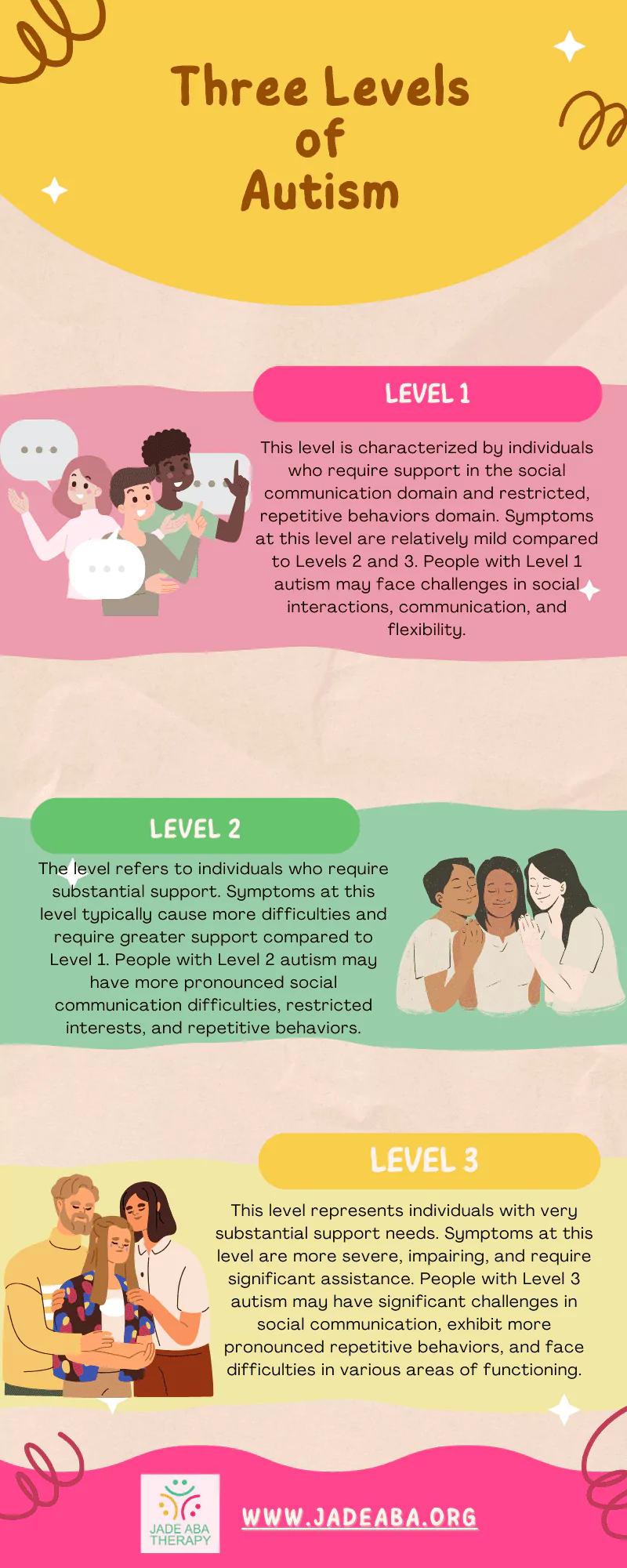To better understand the range of experiences and support needs associated with autism, it is important to familiarize ourselves with the concept of autism levels.
Autism is a spectrum disorder, and individuals with autism spectrum disorder (ASD) may exhibit a wide range of characteristics and support requirements. Here, we’re going to provide an overview of the autism spectrum and highlight the significance of support levels.

Overview of Autism Spectrum
The autism spectrum refers to the range of behaviors, abilities, and challenges that individuals with ASD may experience. It acknowledges the diversity within the autism community.
According to the Diagnostic and Statistical Manual of Mental Disorders, fifth edition (DSM-5), which is widely used for diagnosing autism, autism is a spectrum disorder. This means that individuals with autism can vary in the severity and impact of their symptoms.
The spectrum encompasses individuals with different levels of functioning and support needs.
The concept of autism levels helps in understanding and categorizing the support needs of individuals with autism.
The DSM-5 classifies autism into three levels, which provide a framework for assessing the extent of support an individual may require. It is important to note that determining an individual’s specific level of autism can be challenging, as symptoms may vary across different areas and support needs may differ for each person.
The three levels of autism are as follows:

It is important to remember that autism levels are not fixed categories, and an individual’s needs may vary across different domains and throughout their life. The focus should always be on understanding and addressing the specific strengths and challenges of each person with autism, providing them with appropriate support tailored to their unique needs.
Level 1 Autism
In the classification of Autism Spectrum Disorder (ASD) levels, Level 1 refers to individuals who require support but do not need a significant amount of it. These individuals may exhibit certain characteristics and have specific support needs that are distinct from Level 1 autism.
Characteristics and Support Needs
People with Level 1 autism may face challenges in social communication and interaction. They may experience difficulty in understanding and interpreting social cues, making it harder for them to establish and maintain relationships.
These individuals may have a limited repertoire of social behaviors and might struggle with initiating and sustaining conversations.
Additionally, individuals with Level 1 autism may exhibit restricted and repetitive behaviors. They may have specific interests and engage in repetitive routines or rituals. They may also display inflexible thinking patterns and have difficulty adapting to changes in their environment or routine.
In terms of support needs, individuals with Level 1 autism may benefit from therapy or coaching for social communication. These interventions can help them develop effective communication skills, improve their ability to understand social cues, and enhance their social interactions.
Accommodations in school settings, such as extra time for tests, may also be beneficial. Support from an education assistant can further facilitate their learning and participation in academic activities.
Impact on Daily Life
Level 1 autism can impact various aspects of daily life. Individuals may experience challenges related to anxiety, switching activities, organization, and planning. They may require additional support to navigate transitions and manage their daily routines effectively.
It’s important to note that the impact of Level 1 autism can vary from person to person. While some individuals may require minimal support, others may need more assistance in certain areas.

Level 2 Autism
Level 2 autism is characterized by traits and support requirements that fall between Level 1 and Level 3 on the autism spectrum. Individuals with Level 2 autism exhibit more pronounced symptoms compared to Level 1, but the severity is lower than Level 3.
Characteristics and Support Needs
People with Level 2 autism require substantial support in both the social communication domain and the restricted, repetitive behaviors domain, according to the DSM-5 criteria. While they may share some characteristics with Level 1 autism, these traits are more pronounced and have a greater impact on daily life.
Individuals at Level 2 may struggle with social interactions and communication, finding it challenging to engage in ways accepted by neurotypical society. They may have difficulty understanding social cues, maintaining conversations, and developing meaningful relationships.
Additionally, they may engage in repetitive behaviors and have specific interests that may not align with typical behaviors.
In educational settings, individuals with Level 2 autism may require additional support such as scribing or reading assistance. They may benefit from participating in social skills groups to enhance their social interactions and build relationships.
Impact on Daily Life
People with Level 2 autism face a range of challenges that can impact various aspects of their lives. These challenges may include:
- Social Communication – Difficulty understanding and responding to social cues, maintaining conversations, and interpreting non-verbal communication.
- Anxiety – Heightened anxiety levels due to challenges in social situations and difficulty adapting to changes in routines.
- Switching Activities – Difficulty transitioning between activities or tasks and may require support to navigate these transitions smoothly.
- Organization and Planning – Challenges with organization and planning which makes it harder to manage daily tasks and responsibilities.
- Independence – Difficulty achieving independence according to neurotypical expectations, requiring varying levels of support in daily living skills.
It’s important to note that individuals with Level 2 autism may find it harder to mask their autistic traits compared to those with Level 1. This can lead to a greater need for support and understanding from their families, caregivers, and the broader community.

Level 3 Autism
Level 3 autism is characterized by significant difficulties in communication, social interactions, and self-regulation. Individuals with Level 3 autism require very substantial support and have high support needs compared to Levels 1 and 2.
They may also engage in repetitive behaviors and face challenges with daily living tasks.
Characteristics and Support Needs
Autistic individuals assessed at Level 3 have more severe and impairing symptoms compared to the lower levels of autism. They require the most support in various aspects of their lives.
These individuals often experience significant difficulties expressing themselves accurately and may face challenges in understanding and using verbal and nonverbal communication. They may struggle with initiating and maintaining social interactions, making it difficult to form meaningful relationships.
Individuals with Level 3 autism may exhibit difficulties with self-regulation, which can lead to emotional and behavioral challenges. They may have difficulty managing their emotions, controlling impulses, and adapting to changes in routines or environments.
This can result in significant distress and may require intervention from caregivers and professionals.
Impact on Daily Life
Level 3 autism requires substantial support, with individuals requiring assistance in various areas of their lives. They may benefit from therapies and interventions at a more comprehensive level to address their specific needs. These may include behavioral therapies, speech and language therapy, occupational therapy, and specialized educational programs.
In terms of communication, individuals with Level 3 autism may require the use of augmentative and alternative communication (AAC) tools to help facilitate their understanding and expression.
These tools can range from picture-based communication systems to electronic devices that generate speech.
Education accommodations for individuals with Level 3 autism might include one-on-one time with an education assistant or support person who can provide personalized assistance and guidance.
Specialized programs for functional literacy and numeracy can also be beneficial to ensure that educational goals are tailored to the individual’s needs and abilities.
Accessing Care and Services
Accessing appropriate care and services is crucial for individuals with autism. Once a diagnosis has been established, there are various resources and programs available to support individuals on the spectrum.
However, navigating the healthcare system and understanding the available options can be overwhelming for parents and caregivers.
Pediatricians can guide families in accessing the right care and services for their children. They can provide recommendations for therapists, specialists, and support organizations that specialize in autism. They can also help families understand the eligibility criteria and the process of accessing services through government programs, insurance, or other funding sources.
By collaborating with pediatricians and taking advantage of their expertise, parents and caregivers can ensure that their loved ones on the autism spectrum receive the most appropriate care and support.
Through early intervention, comprehensive treatment plans, and access to the necessary services, individuals with autism can thrive and reach their full potential.
Sources:
- https://www.healthdirect.gov.au/autism
- https://www.lanermc.org/community/lane-health-blog/the-3-levels-of-autism-explained
- https://www.verywellhealth.com/what-are-the-three-levels-of-autism-260233
- https://psychcentral.com/autism/levels-of-autism
- https://www.verywellmind.com/what-are-the-levels-of-autism-5271572